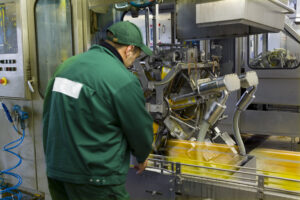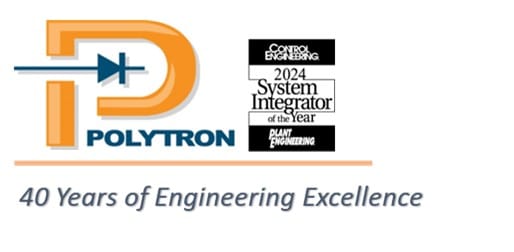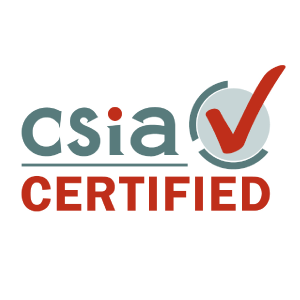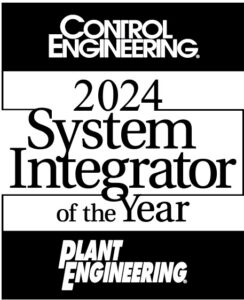New line requires quick commissioning and startup while ensuring company safety specifications are met with machines coming from multiple vendors.
Getting the line into production without delays or compromising the company’s safety standards could avoid expensive and timeconsuming delays saving lost revenue and customer relationships.
The manufacturer needed a certified third-party partner to ensure project success by implementing the company’s safety standards for all equipment in the new line. A single source for all safety-related information, documentation, verification and validation for compliance would mean savings in time, ROI, and meeting the project timelines.
Challenge |
Solution |
Results |
| Need quick commissioning and startup to get new line in production as soon as possible, while still ensuring new machines coming from multiple vendors comply with company safety specifications. | Certified third-party safety partner to manage verification and validation:
|
Identified out of spec items and corrected early in the process for the OEM safety systems that did not conform to company standards
Resolved out of standard equipment even before coming onsite Reduced project disruption getting machinery into production Reduced startup/commissioning time Reduced possibility of on-machine injuries, OSHA fines, and machine downtime |
The Project
 Safety Standard Requirements Posed Risk to On-time Project Delivery
Safety Standard Requirements Posed Risk to On-time Project Delivery
The senior project manager at a beverage manufacturer was under pressure to get a new line into production as quickly as possible to meet customer demand while meeting company safety standards.
The additional line would include new machinery sourced from a variety of OEMs, and all of it would need modifications to meet company safety standards.
With machinery coming from multiple vendors, ensuring safety compliance introduced a project risk of expensive and time-consuming delays to get the new line up and running. These delays would impact the ability to meet consumer inventory commitments resulting in revenue losses.
Finding Resources to Conduct Pre-Shipment Machine Safety Verification and Validation
The project manager needed a reliable method for meeting the safety standards to be confident that the commissioning and startup occurs on time.
This required someone to be dedicated to guide and track each machine vendor to ensure the new equipment would meet the manufacturer’s safety standards and specifications.
Unfortunately, his team just didn’t have the time to dedicate to such a labor-intensive project. He didn’t want his team to be responsible for delays in production, but he could see that solving the safety verification and validation problem itself would also be time-consuming and complicated.
He solved his dilemma. Polytron was brought into the project to manage the OEMs for the new machine safety verification and validation scope of the new line project.
Single-Source Vendor Management for Safety Standards
Polytron’s TÜV Certified team began with an extensive review of the manufacturer’s safety standards and meetings with the company’s safety leads to fully understand requirements for all new machinery being delivered.
With pre-shipment verification, vendors serving this manufacturer knew prior to shipment what was required for their machines to meet their customer’s specific standards. This helped prevent onsite safety system issues that potentially would impact project schedule and budget.
OEM compliance was verified by reviewing:
- Machine drawings packages
- Machine functional specifications (or develop safety functional design specifications, if none exist)
- Risk assessments (where available)
- Required Robotic safety documentation
- Safety hardware of the control system
- Safety programming logic
For each machine, detailed design documentation was created to report final safety design adherence to the client’s company safety standards. The documentation followed along with the machine from the vendor’s site, installation at the plant, and final site acceptance. All reports were then filed with the company’s safety-related documentation.
This process significantly reduces startup time and the need to re-design or correct any issues onsite that relate to safety. The benefit of this approach was that the vendor’s design time was decreased and completed within the project schedule. Vendors had a dedicated guide with the delivery time and full understanding of the standards to ensure compliant machines were deployed efficiently, effectively and on time.
Thorough Verification Process Speeds Ensures Successful Validation
The senior project manager was aware that machine safety documentation is not the final step and that validation would be critical to ensure the machines were truly safe once installed.
As a third-party safety systems integrator, Polytron was able to serve as an objective TÜV Certified validator, applying a proven process that includes documenting adherence to all ISO 13849-2 requirements, among others.
Achieving Certainity of Outcome
Working together, the senior project manager, his team, vendors, OEMs and Polytron were able to put the line into operation on time – and safely.
Polytron’s team of TÜV engineers identified and corrected, at the early stages, the OEM’s safety systems not in compliance with the standards. Through reviews of 100s of drawings, 100s of safety devices, 1000s of lines of PLC code, we were able to deliver a complete report detailing how each OEM provided a machine that completely met the manufacturer’s safety standards.
Knowing this portion of the project was thoroughly verified by a third-party allowed the senior project manager to better focus on the many other aspects of implementing new machines- saving time and cost.
Polytron’s process of verification (during design) and validation (after commissioning) helps OEMs, the manufacturer, operators, maintenance, and OSHA recognize that the machine installed is being operated safely. This assurance greatly reduces the risk of on machine injuries, OSHA fines, and machine and production downtime.
Polytron’s Verification and Validation process documentation is on file with the manufacturer and available for vendors to reduce design time for future projects as well.



